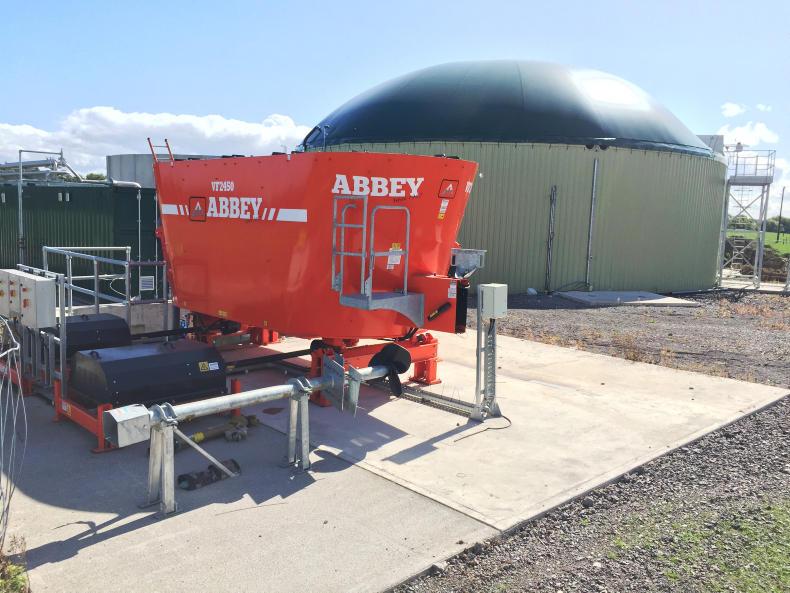Gas Networks Ireland has hired KPMG to conduct a consultation on its plan to source 20% of the gas distributed through the national network from agricultural anaerobic digesters (AD) by 2030.
The plan would require up to 250 ADs to be built across the country at a cost of several million euro each. KPMG’s Russell Smyth said this would represent a €1.5bn to €2bn investment in the rural economy to be realised by investors in partnership with farmers and local communities.
“For this to work, it has to be community-led and located on farms or near farms,” he told a meeting of farmers, co-ops, merchants and agricultural state bodies at Teagasc Grange last Thursday.
Listen to "Involving farmers in gas production" on Spreaker.
Ian Kilgallon of Gas Networks Ireland said all areas of the Republic except Co Donegal and parts of counties Sligo, Leitrim and Kerry were within reach of the existing network. He said the project could create 6,500 rural jobs and help to reduce greenhouse gas emissions from agriculture through better slurry management.
He referred to Teagasc’s Grass 10 study showing that the national average annual grass production is currently 6t DM/ha but could be increased to 10t DM/ha or more.
Grass to be used as feedstock for ADs should come from such improved grassland efficiency rather than displace fodder production. “It is remarkably bad timing to be presenting a heavily grass silage-based strategy in the middle of a fodder crisis,” Smyth acknowledged, highlighting the need for a concerted strategy with farmers to source the slurry and the 10m tonnes to 12m tonnes of fresh silage needed to achieve the plan by 2030.
Participants highlighted the need for flexibility in directing fodder to livestock as a priority, with a centralised buying system preferable to individual farmers committing large quantities of grass to local ADs under long-term contracts.
They also highlighted the need for attractive prices set in a way that farmers can trust. “The economics of this have to be crystal clear from top to bottom,” said Tommy Cooke of the ICMSA. Those with AD experience warned of the high level of technical knowledge required.
JJ Lenehan of Teagasc gave participants a tour of the Grange research AD, which is due to be completed by the end of this year.
Teagasc is currently sourcing silage from neighbouring farms at between €25/t and €30/t on three-year contracts, close to prices observed in Northern Ireland where the price paid by AD plants is £27.50/t at 25%DM.
Gas Networks Ireland will use results from the consultation to seek a level of Government support that would make the project viable through the proposed extension of the new Support Scheme for Renewable Heat.
Read more
Gas for grass – €28/t for raw silage
Big players prioritised over farmers in renewable energy acceleration
Heat scheme to begin without biomass option
Listen: hope and bottlenecks at Energy in Agriculture 2018
Dempsey at Large: energy is where it's at
Gas Networks Ireland has hired KPMG to conduct a consultation on its plan to source 20% of the gas distributed through the national network from agricultural anaerobic digesters (AD) by 2030.
The plan would require up to 250 ADs to be built across the country at a cost of several million euro each. KPMG’s Russell Smyth said this would represent a €1.5bn to €2bn investment in the rural economy to be realised by investors in partnership with farmers and local communities.
“For this to work, it has to be community-led and located on farms or near farms,” he told a meeting of farmers, co-ops, merchants and agricultural state bodies at Teagasc Grange last Thursday.
Listen to "Involving farmers in gas production" on Spreaker.
Ian Kilgallon of Gas Networks Ireland said all areas of the Republic except Co Donegal and parts of counties Sligo, Leitrim and Kerry were within reach of the existing network. He said the project could create 6,500 rural jobs and help to reduce greenhouse gas emissions from agriculture through better slurry management.
He referred to Teagasc’s Grass 10 study showing that the national average annual grass production is currently 6t DM/ha but could be increased to 10t DM/ha or more.
Grass to be used as feedstock for ADs should come from such improved grassland efficiency rather than displace fodder production. “It is remarkably bad timing to be presenting a heavily grass silage-based strategy in the middle of a fodder crisis,” Smyth acknowledged, highlighting the need for a concerted strategy with farmers to source the slurry and the 10m tonnes to 12m tonnes of fresh silage needed to achieve the plan by 2030.
Participants highlighted the need for flexibility in directing fodder to livestock as a priority, with a centralised buying system preferable to individual farmers committing large quantities of grass to local ADs under long-term contracts.
They also highlighted the need for attractive prices set in a way that farmers can trust. “The economics of this have to be crystal clear from top to bottom,” said Tommy Cooke of the ICMSA. Those with AD experience warned of the high level of technical knowledge required.
JJ Lenehan of Teagasc gave participants a tour of the Grange research AD, which is due to be completed by the end of this year.
Teagasc is currently sourcing silage from neighbouring farms at between €25/t and €30/t on three-year contracts, close to prices observed in Northern Ireland where the price paid by AD plants is £27.50/t at 25%DM.
Gas Networks Ireland will use results from the consultation to seek a level of Government support that would make the project viable through the proposed extension of the new Support Scheme for Renewable Heat.
Read more
Gas for grass – €28/t for raw silage
Big players prioritised over farmers in renewable energy acceleration
Heat scheme to begin without biomass option
Listen: hope and bottlenecks at Energy in Agriculture 2018
Dempsey at Large: energy is where it's at






 This is a subscriber-only article
This is a subscriber-only article










SHARING OPTIONS: